May 1, 2023 feature
This article has been reviewed according to Science X's editorial process and policies. Editors have highlighted the following attributes while ensuring the content's credibility:
fact-checked
peer-reviewed publication
trusted source
proofread
Developing multiple concentration gradients for single cell–level drug screening
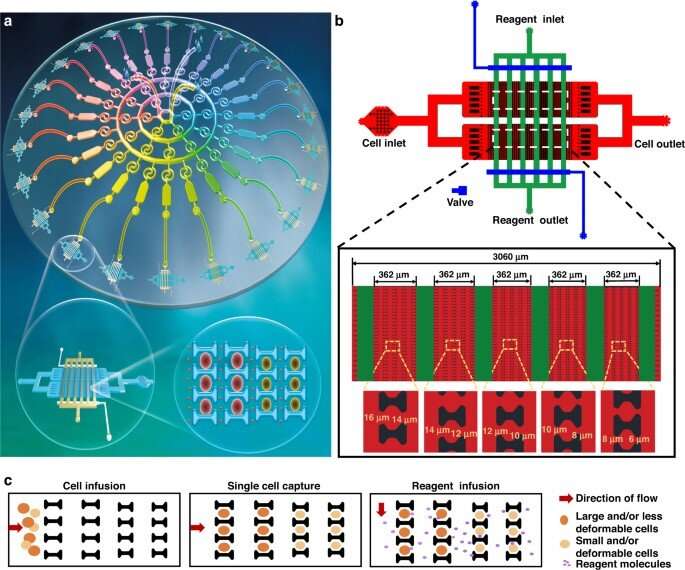
The potential to isolate and regulate the biodynamics of single cells is significant in drug design and screening. However, pre-existing experimental reports in single-cell drug screening must yet provide multiple-dose gradient studies, to accurately predict drug–single cell interactions and performance. In a new report in Microsystems and Nanoengineering, Shaofei Shen and a team of scientists in life sciences and medicine in China solved this problem by creating a multi-concentration gradient generator.
They combined the gradient generator with a single-cell capture array, to understand the impact of single or combined doses of 5-fluoro uracil and cisplatin anticancer drugs on human hepatoma cells and human breast cancer cells, at the single-cell level. The instrument provided a simple and reliable platform to study the correct dosage of different drug candidates at the single cell level to screen single-agent chemotherapy agents and efficiently form combinatorial therapy regimes.
Developing a new drug screening platform
Drug screening methods offer a visible solution to prevent infections and treat human disease. Broad research efforts have shown that microfluidic chip technology offers a microanalysis platform for easy access and biocompatibility. Most microfluidic systems offer a powerful instrument to study cell populations at the level of single cells, while facilitating dose-dependent cellular responses at different drug concentrations. In this work, Shen and colleagues optimized a multistage microfluidic device combined with a single-cell capture array to generate a single-cell microfluidic drug screening platform across multiple drug doses.
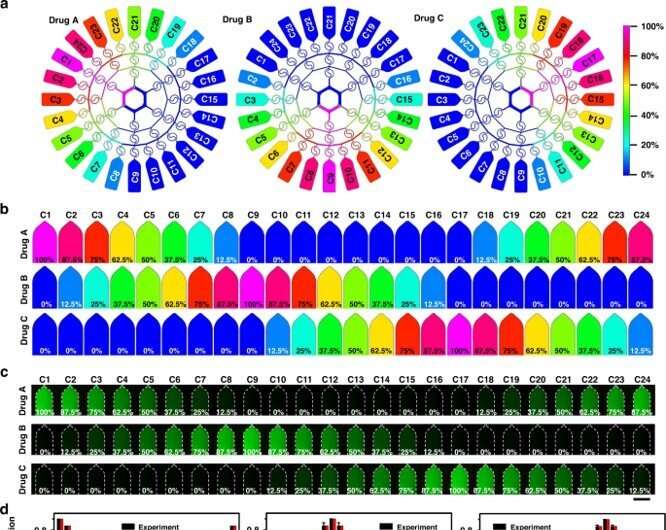
In this work, the researchers calculated the concentration gradient generated in theory, and verified it in a fluorescent experiment. They used cisplatin and 5-fluorouracil; two chemotherapeutic agents as model drugs for single or multidrug combinatorial chemotherapy on human breast cell carcinoma cells and human hepatoma cells at the single-cell level. The system provided a flexible and well-regulated instrument to study pharmacological functions and conduct single-cell research.
Designing the microfluidic platform
Shen and the team designed and constructed the microfluidic platform containing 24 single-cell capture devices. They generated a series of successful drug concentration gradients in the device, where the concentration-gradient generator could jointly screen two drugs, allowing them to study a single drug and multidrug combinations alongside their optimal dosage.
The bioengineers facilitated the single-cell capture device to contain a two-dimensional array with cell and reagent portals for cell suspension and reagent import, as described in a previous study by the same team.
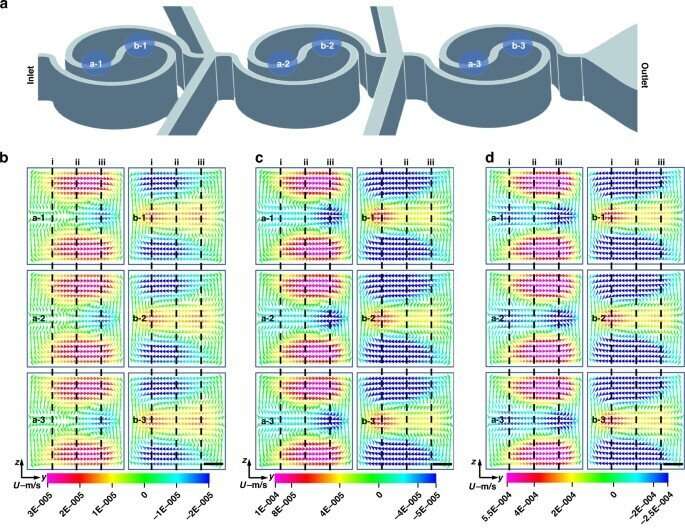
Three-concentration gradient formation
The researchers tested the capacity of the device to establish three concentration gradients via numerical simulations and fluorescein experiments, to explore drug distributions in 24 microcavities. Using an inverted microscope, they gathered fluorescent images and used imaging software to understand the data gathered for each chamber.
The simulation showed the formation of three groups of identical drug concentrations in the designed device and their percentage. Alongside the simulations, they conducted fluorescein experiments to verify the concentration gradient distribution in 24 liquid storage chambers. They injected two fluorescent agents into the chip from the entrances and observed how the experimental outcomes agreed with the results of numerical simulations.
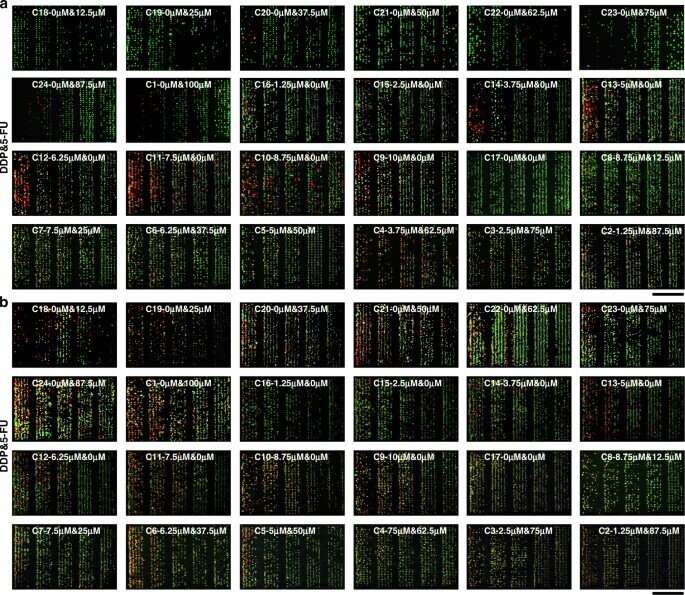
Tai Chi-spiral mixer–induced Dean flow in microfluidics
The team used a Tai Chi-spiral mixer in the concentration gradient generator and incorporated Dean flow in the curving channels for microfluidic applications of fluid regulation, as a revolutionary approach to mix, purify and focus on reactions efficiently and cost-effectively.
They obtained a stable and effective multidrug concentration gradient for single-cell drug screening via the formation of three concentration gradients and constructed a multiple-concentration platform for single-cell level drug screening to observe the combined and separate effects of the anticancer drugs cisplatin and 5-fluorouracil.
Drug screening with single-cell-drug interactions
The bioengineers applied a drug containing medium with different concentrations of the two cell types; human breast cell carcinoma cells and human hepatoma cells in single-cell capture microfluidic devices and in traditional Petri dishes. Using double fluorescence staining methods; acridine orange and propidium iodide, they validated the cell viability and observed variations in cell activity when exposed to different drug concentrations to show how the survival rate of the tumor cells improved as the concentration of the drug decreased in the culture devices.
While the cell vitality negatively correlated with the drug dose in healthy cells, tumor cells were unaffected by cell interactions at the single-cell level for effective investigations of their susceptibility to drugs.
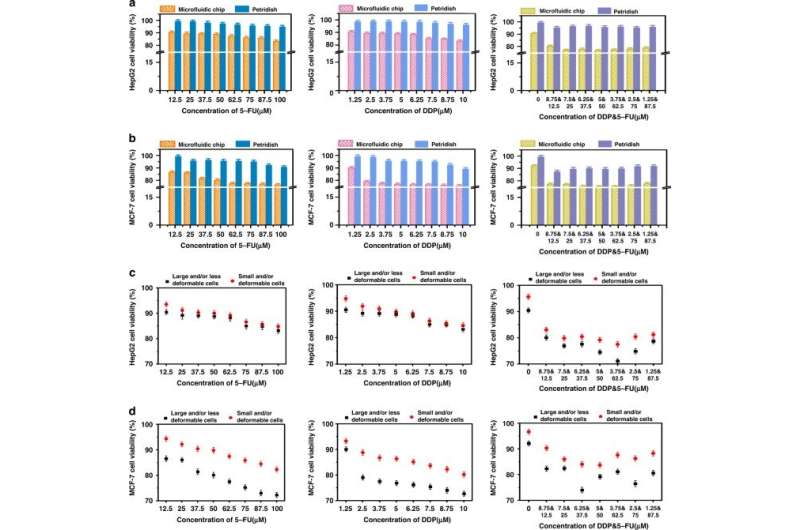
The team combined two drugs on the cells in the platform and noted a stronger synergistic effect of two drugs compared to monotherapy alone. The phenomenon is also present in microfluidic single-cell capture devices to offer effective monotherapy and combination therapy strategies. For instance, cells exposed to 5-fluorouracil underwent dose lethality to inhibit DNA synthesis and cell mitosis, highlighting the significance of drug screening to explore tumor cell heterogeneity across diverse drug gradients. The work has significant impact on broader biological and preclinical explorations, including cancer stem cell separation and drug discovery.
Outlook
In this way, Shaofei Shen and colleagues generated a simple and efficient multifunctional microfluidic drug screening device for single-cell level functionality. The device contained a concentration gradient drug generator and single-cell capture array suited for multiple purposes.
They combined the single-cell capture device on the platform to implement separate doses of two anticancer drugs, on two different cancer cell lines. The work provides a strong starting point to study the sensitivity of multiple anticancer agents at the level of single cells and stem cells, to implement effective chemotherapeutic strategies.
More information: Shaofei Shen et al, Construction of multiple concentration gradients for single-cell level drug screening, Microsystems & Nanoengineering (2023). DOI: 10.1038/s41378-023-00516-0
Leonard I. Zon et al, In vivo drug discovery in the zebrafish, Nature Reviews Drug Discovery (2005). DOI: 10.1038/nrd1606
Journal information: Nature Reviews Drug Discovery
© 2023 Science X Network



















